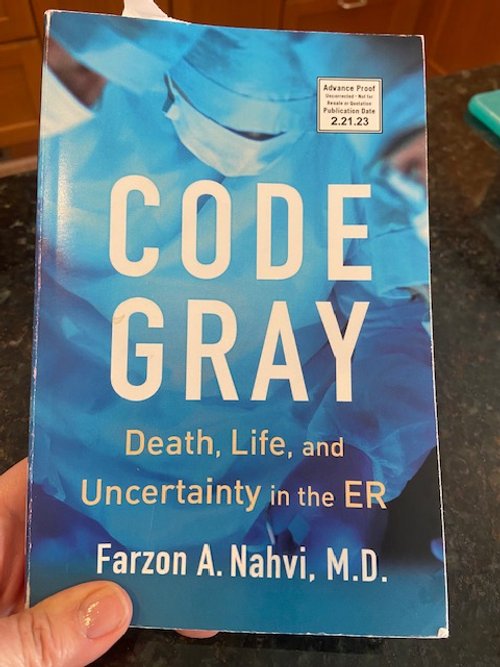#112 Life, Death, and Uncertainty in the ER
A Review of Farzon Nahvi’s Code Gray
photo by Joan Naidorf
Very rarely, I come across a book that captures the essence of my professional experience as an emergency physician. As an avid reader and reviewer, I have read several medical memoirs that did indeed come close. They tend to be compilations of the most moving (and awful) experiences that occur in the lives of the physicians and staff of the emergency department.
I am pleased to say that in his book, Code Gray, Dr. Farzon Nahvi has absolutely captured the essence of the great privilege, joy, despair, and uncertainty of working in a modern urban emergency department. Additionally, as an emergency physician in New York City during the early months of 2020, the days of first wave of the deadly Covid-19 Pandemic, Nahvi draws back the opaque curtain on what was really happening and how front-line medical staff were sharing information and trying to figure out how to treat the novel Corona Virus.
A Pandemic Bonus Section
Nahvi’s book is really two in one. The first part entitled “Prologue” was what that the young doctor never expected to become part of his publication. When the epidemic of Covid-19 began, very little was known and the traditional time lines testing evidence-based medical treatments were far too slow to be of use to the physicians, nurses, and respiratory therapists faced with the first wave of afflicted patients. What the author includes are the redacted text messages between himself and his colleagues working in the emergency departments of other cities.
Nahvi and his colleagues describe running out of medications used to sedate people before intubation. They describe shortages of personal protective equipment, IV pumps, antibiotics, and ventilators. They describe the shear ferocity and rapidity of the disease progression that took patients before they even arrived at the hospital or the intensive care unit. The author was particularly distressed over how he could accurately tell the patients or their families themselves about the terrible course and prognosis of Covid-19 that medical professionals knew so little about and were not substantially able to change.
The rapid spread of Covid-19 stressed a healthcare system that was already stressed. Nahvi writes, “Covid-19 was not a wrecking ball, then, but a magnifying glass. It did not break American medicine but reveal it for what it has always been…Long before the pandemic had ever hit, our experiences were challenging, strange and discomfiting. Long before the pandemic had hit, our routine was to encounter impossible situations for which there exists no answers, and to answer them.” (p. 47)
One simultaneously routine and exceptional afternoon
The majority of Code Gray focuses on an intense examination of one particular afternoon in the emergency department that Nahvi calls “simultaneously routine and exceptional.” Although he focuses on the treatment of one critically ill patient and the interactions with her husband, he loops in several other patient care experiences and the difficult lessons that he learned during his years of training.
One specific point that Nahvi explores is the universal experience that physicians have when they must deliver bad news to their patients. In painful detail, he brings in several examples from his own career, and others’, of how physicians routinely fail in this endeavor. He notes that the softening of bad news with euphemistic language like “mass” instead of cancer or “not doing well” instead of dying, assuages the feelings of the physician delivering the news but only harms the patient or the family.
The author concludes,
“Ultimately, using anything but honest and frank language is not something that we do for our patients, but for ourselves. We may believe we are softening our blows for our audience but we know that, in the end, doing so does not actually help them… we do this to avoid our own discomfort.” (page 153)
Tied back to the central patient case narration, Nahvi faces the uncertainty of how to deliver the devastating news of the patient’s cause of death to the husband. Even exposing that one fact, opens a gray area of questions and conundrums. The author presents the many of the dilemmas faced by compassionate physicians and healthcare professionals in our system. What can we do when the rules of the system deny treatment to some or offers no realistic care for unhoused or uninsured people in our care? How can we be honest with our patients without blaming them for their illness or injury?
Nahvi writes,
“When I was a medical student, many of the professors spoke about the sense of pride we would one day feel upon appreciating the awesome responsibilities that our profession entrusted with us with. They never once mentioned the inverse. They never mentioned the deep sense of shame we routinely feel in knowing that our profession lets so many of our patients down.” (page 175)
The professors did not know yet about moral injury and burn out. Nahvi knows and shares thoughtful explorations of the gray areas with his readers, not just in the abstract, but with real and relatable patient case histories from his years training in residency and as a young attending physician. For the public, much of what they read in Code Gray may be new and shocking in nature. Physicians reading the book will find themselves nodding in agreement and remembering many similar situations that they lived and worked through.
Nahvi artfully presents the trials and tribulations of the emergency department, not just the exciting narrative, but as metaphor for life in general. He writes,
“…life sometimes contains no perfect solutions and no correct courses of action. We are often surrounded by unknowns, and yet, we must take action. We are routinely presented with the impossible situation where there exists no right thing to do.” (p. 139)
Readers of Code Gray will come to understand, in Nahvi’s detailed and lyrical prose, how uncertain the art and science of medicine actually is.

